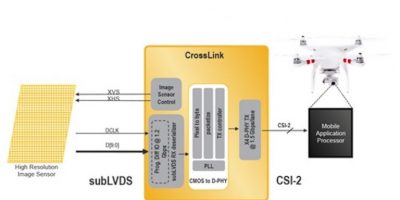Image sensor bridge helps robotics says Lattice Semiconductor
For industrial vision applications, Lattice Semiconductor has developed the SubLVDS to MIPI CSI-2 image sensor bridge reference design.
The CrossLink reference design helps machine vision and robotics applications leverage advanced application processors, explains the company.
The SubLVDS to MIPI CSI-2 image sensor bridge reference design provides industrial device customers with a flexible, easy-to-implement means to connect advanced application processors (APs) with many of the image sensors currently used in today’s machine vision applications for industrial environments.
Many industrial machine vision applications use image sensors with a SubLVDS interface, which is incompatible with the MIPI CSI-2 D-PHY interface on today’s APs. However, many industrial device OEMs want to implement these APs in existing machine vision-capable products. The Lattice SubLVDS to MIPI CSI-2 Image Sensor Bridge reference design lets customers create a bridging solution so an AP with a MIPI CSI-2 interface can connect to a SubLVDS image sensor to upgrade legacy machine vision applications.
Peiju Chiang, product marketing manager, Lattice Semiconductor, explained: “Rather than devote precious time and engineering resources on an extensive device redesign, the Lattice CrossLink SubLVDS to MIPI CSI-2 Image Sensor Bridge reference design provides a simple workaround that addresses legacy interface compatibility issues to get redesigned products to market quickly and cost effectively”.
The Lattice SubLVDS to MIPI CSI-2 image sensor bridge reference design demonstrates the use of Lattice’s CrossLink modular IPs, including the Pixel-to-Byte converter, SubLVDS image sensor receiver and a CSI-2/DSI D-PHY transmitter. It is available free of charge from Lattice Semiconductor. The company also provides Diamond design software, a GUI-based FPGA design and verification software environment, to simplify and accelerate device development.
Lattice Semiconductor specialises in low power programmable devices. It addresses customer problems across the network, from the edge to the cloud, in the growing communications, computing, industrial, automotive and consumer markets. The company believes its technology, long-standing relationships, and commitment to customer support lets customers create a smart, secure and connected world.




